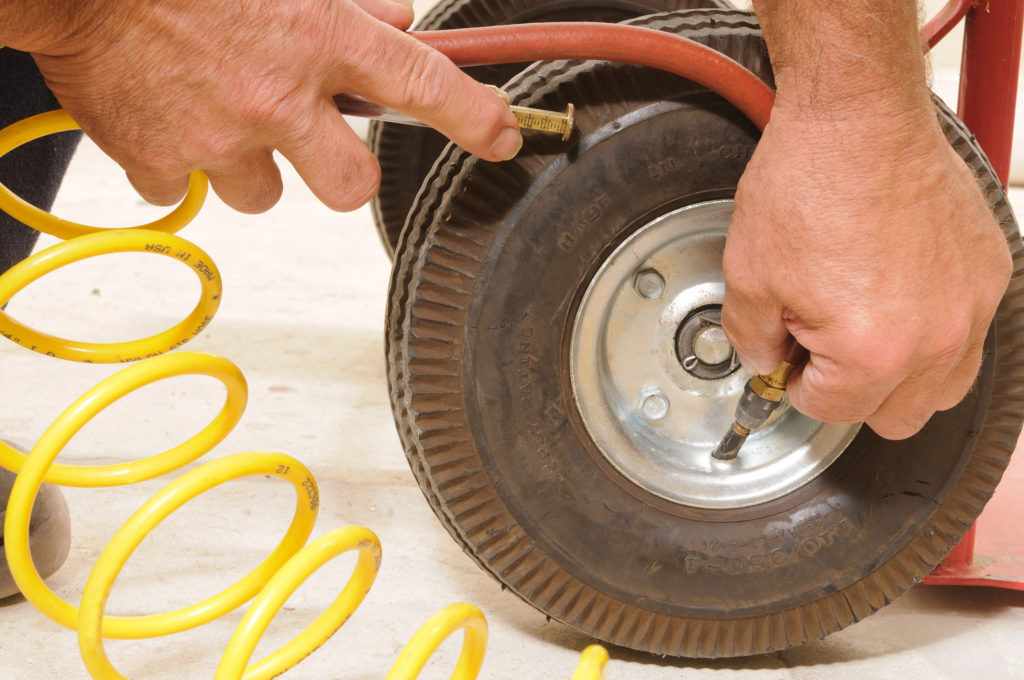Air compressors can be used for a whole host of applications. We take a closer look at how to use an air compressor and what to use it for.
Air compressors have been in use for about 4,000 years. Don’t believe us? Well think about this, the first use of compressed air was to fuel fire.
Hand operated bellows would be pumped to gather and blow fresh oxygen-rich air into the fire. This was especially useful in the metal making process.
Today’s air compressors are a bit more complicated, but not by much. You shouldn’t be intimidated about how to use an air compressor.
We are going to through step by step what you need to do to use an air compressor. Then we’ll review some common personal and industrial uses for compressors.
What Is an Air Compressor?
You can probably guess from its name, but an air compressor is a tank that compresses a certain amount of air and then holds it. That compressed air can then get used later for a variety of functions.
How to Use an Air Compressor
There was a time when only the most dedicated of DIYer or home handyman would have an air compressor. These days though, because there is a wider variety of sizes available, you can find them in many more homes.
Think it would be a good idea to buy one for your home garage? Great! The first thing you need to do is learn how to use it.
Plug It in
The first step is to plug it into power. Before you do though, make sure the on/off switch is in the “off” position. Then place the compressor on a solid, flat surface.
Fill the Tank
Before you try to start filling the tank, check to make sure the drain plug is in place. You can tighten it down with an adjustable wrench.
Then turn the tank on and let it start filling with air. Check the automatic shut off to make sure it is going turn off around 100 to 115 psi. Your user manual can give you the exact pressure number.
Adjust the Air Control Valve
While the tank is filling check your tool for the maximum amount of air pressure allowed for it. Then adjust the air control valve on the compressor to match.
Connect the Air Hose
Once the motor shuts off, your tank should be full of compressed air. At this point, you can connect the air hose.
You’ll want to make sure you can reach your intended workspace with the other end of the hose. If not, then you need to move the air compressor to the hose will reach.
For a really airtight secure seal, wrap the threads with a couple layers of Teflon tape. Then tighten it down with an adjustable wrench.
If your hose has a quick-connect setup then you can skip the tape step. Just pull back the cover, pop into the connector, and release the cover back into place.
Connect the Tool
Next, you need to connect the tool you intend to use to the other end of the hose. These tools are often referred to as pneumatic tools.
They almost always have a quick-release connection. Same as the hose, you’ll pull back the protective collar, push into place, and release the collar back.
The same process works to take the tool off. Slide the collar back, pull out of the connector, and release the collar.
Release Air and Drain
Once you are done using the air compressor you must put it away correctly. This will ensure your air compressor lasts.
First, disconnect your tool and the hose. Open the valve and release the air pressure from the tank. Then you’ll need to drain the moisture from the tank.
As you compress air, the moisture in the air gathers in the tank. This water must be drained.
Air Compressor Uses
You will find that air compressors that are meant for personal use are smaller and portable. They could be small enough to carry in one arm. Or they are larger requiring wheels to move them around.
Professional use air compressors are quite large. They are rarely portable. For this application, they are usually permanently installed into the shop or facility location.
Personal Use
Most personal use air compressors are going to hold enough air for you to get a project done. If your home improvement project is larger, you may hear the compressor kick on to refill your tank as you work.
Tires
This is the most common use of an air compressor in the home setting. You can use it to refill your bike or car tires. This is a great way to regularly check and maintain the proper air pressure in your tires.
Painting
If you want to paint your home, compressed air can help.
Instead of using a brush and roller and painstakingly go over every inch of the wall, use a sprayer. Just hook the paint reservoir and sprayer up to the hose.
You’ll then be able to spray the paint onto the wall, allowing you to move evenly and quickly throughout your home.
Tools
Some of the more common examples of the tools you can use with your air compressor are on the list below. The project that you are working on will dictate which tool you need.
- Ratchet
- Hammer
- Screwdriver
- Drill
- Sander
- Nail gun
- Saw
- Sandblaster
There are hundreds of different types of tools that you can buy. Before you go nuts buying tools though, really consider if it is worth the investment.
For example, there is a pneumatic paint shaker. Sounds cool right? Except how often are you going to use it after this one house painting project. Probably not very often.
Inflatables
It’s summertime and you have a ton of rafts and floats to blow up. Doing it the old fashioned way will leave your lungs exhausted.
Instead, use your air compressor! It will turn a project that feels like hours into a few zippy minutes. That will get you out there enjoying the summer faster.
Professional Use
From small businesses to large industrial operations, air compressors are vital. When it comes to professional use, the compressed air is used more like an energy source.
Small Business
The most common use for smaller businesses is tools. Similar to personal use, but on a larger scale. You’ll see one air compressor powering multiple tools on a construction site.
Industrial Use
When it comes to large-scale industrial use, the air compressor takes on a few differences. This is because companies don’t want production downtime while they wait for the tank to refill.
To address this, a screw compressor is used. These compressors allow for constant and continued use.
Farming
Air compressors help farmers get more work done than what they could do on their own. They can move, feed and gain via a conveyor. This makes moving grain from the storage silo to somewhere else much easier and faster.
Ever notice those sprayers that are in the crop fields? Those sprayers have air compressors powering them. This makes for a more regulated and even delivery system.
Manufacturing
Pretty much all manufacturing relies on air compressors. Everything from the tools on the line to moving the product through the system needs compressors.
Metal manufacturing uses compressor powered sandblasters to polish it. Anything that requires nails or screws get assembled with the power of a compressor.
Ever notice how perfect the packaging is around some projects? That’s thanks to air compressors. They will inject liquid padding, assemble the box, and staple it shut.
Dry Cleaning
The way that dry cleaning works, the cleaning chemicals get delivered through compressor powered jets. They also power the steam cleaners and the presses.
Food and Beverage
Air compressors are used to keep products cold, refilling drink equipment, and packing and palleting product.
What Will You Use Yours For?
By now you should understand how to use an air compressor. You should have a good idea of how you can put one to use in both private and commercial applications.
When it comes to personal use, you can find a variety of uses that will make your life easier. The most common use would be refilling your tires. But if you have a big home project, then looking into some pneumatic tools could make your whole project go faster.
Industrial uses may not be as visible but are vital to making manufacturing and production faster and smoother. This allows for continued operation of the machinery the air compressor powers.
An air compressor would make a great gift for dad, but if yours isn’t the handy type, you should consider these other great gift ideas.













